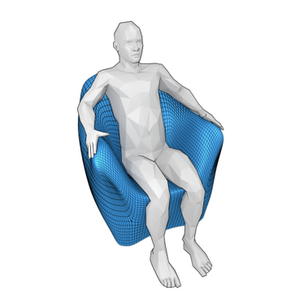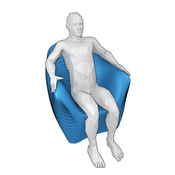Information
- Publication Type: PhD-Thesis
- Workgroup(s)/Project(s):
- Date: May 2023
- Date (Start): 1. March 2016
- Date (End): 31. May 2023
- Second Supervisor: Przemyslaw Musialski
- Open Access: yes
- 1st Reviewer: Bedrich Benes
- 2nd Reviewer: Peter Wonka

- Rigorosum: 31. May 2023
- First Supervisor: Michael Wimmer

- Pages: 115
- Keywords: Computational Design, Computer-Aided Design, Generative Deep Learning, Shape Optimization
Abstract
Humans spend a large proportion of their lives indoors, be it at home, at their workplace, or in public facilities like restaurants or museums, making the design of such indoor spaces an important task. There are many different requirements for both the design of individual pieces of furniture and their arrangement within a given space, making extensive expert knowledge in this field anecessity to achieve the desired design goals in terms of functional, aesthetic and ergonomic quality. While Computer-Aided Design software can aid the user in this task, existing tools often focus on just one specific aspect of the design process. In particular, making sure that a given design adheres to ergonomic guidelines is often left entirely to the designer, making it a difficult task especially for novice users. In this thesis, we explore different approaches of how ergonomic aspects of interior design can be integrated into interactive, automated or data-driven methods for the design of seating furniture and indoor layouts. The first part of the thesis presents an interactive method for the design of seating furniture. Given a triangular mesh of a human body in a specific pose as input, we first compute an approximate pressure distribution on the human body to learn where it needs the most support. A given inital design for a piece of seating furniture is then deformed to provide optimal support to the body while still conforming to the aesthetic design as much as possible. The design can furthermore be modified interactively. We demonstrate that this approach allows even novice users to create comfortable seating furniture designs in a short time span. While an interactive approach provides more control to the user, it also requires substantial manual design effort, making it difficult to use for novice designers. The second part of this thesis proposes a method for the automated generation of seating furniture which depends entirely on the target pose. The designs created with this approach can be used as-is or as an initial design for the approach introduced in the first part of the thesis. Our method for computing the pressure distribution is furthermore extended by taking into account the weight of individual limbs and estimating the frictional forces acting on the body for increased accuracy. Our results show that the proposed method can further improve the designs of seating furniture when used in conjunction with our interactive design tool. Since the ergonomic qualities of seating furniture do not only depend on the design of the furniture itself, but also its relation to the other elements of the surrounding indoor space, the third part of the thesis introduces a data-driven approach for the design of indoor layouts. Since common guidelines for interior design are so numerous, it is an infeasible task to define all of them explicitly when developing a computational design method. Using a data-driven approach makes it possible to implicitly learn about these rules given a large set of suitable examples. But good example data is not always readily available in large quantities; existing datasets may fulfill some of the desired rules, but lack in other areas. We therefore propose a deep-learning approach thatmakes use of the advantages of data-driven learning, while at the same time correcting flaws in the dataset using a small set of explicitly designed rules drawn from ergonomics literature. We evaluate the designs synthesized by this approach using a perceptual study and show that theresults are seen as equally or even more realistic than the ground truth designs that were used to train the deep learning model.
Additional Files and Images
Additional images and videos
Additional files
Weblinks
BibTeX
@phdthesis{leimer-2023-ecd,
title = "Ergonomics-Driven Computational Design of Furniture and
Indoor Layouts",
author = "Kurt Leimer",
year = "2023",
abstract = "Humans spend a large proportion of their lives indoors, be
it at home, at their workplace, or in public facilities like
restaurants or museums, making the design of such indoor
spaces an important task. There are many different
requirements for both the design of individual pieces of
furniture and their arrangement within a given space, making
extensive expert knowledge in this field anecessity to
achieve the desired design goals in terms of functional,
aesthetic and ergonomic quality. While Computer-Aided Design
software can aid the user in this task, existing tools often
focus on just one specific aspect of the design process. In
particular, making sure that a given design adheres to
ergonomic guidelines is often left entirely to the designer,
making it a difficult task especially for novice users. In
this thesis, we explore different approaches of how
ergonomic aspects of interior design can be integrated into
interactive, automated or data-driven methods for the design
of seating furniture and indoor layouts. The first part of
the thesis presents an interactive method for the design of
seating furniture. Given a triangular mesh of a human body
in a specific pose as input, we first compute an approximate
pressure distribution on the human body to learn where it
needs the most support. A given inital design for a piece of
seating furniture is then deformed to provide optimal
support to the body while still conforming to the aesthetic
design as much as possible. The design can furthermore be
modified interactively. We demonstrate that this approach
allows even novice users to create comfortable seating
furniture designs in a short time span. While an interactive
approach provides more control to the user, it also requires
substantial manual design effort, making it difficult to use
for novice designers. The second part of this thesis
proposes a method for the automated generation of seating
furniture which depends entirely on the target pose. The
designs created with this approach can be used as-is or as
an initial design for the approach introduced in the first
part of the thesis. Our method for computing the pressure
distribution is furthermore extended by taking into account
the weight of individual limbs and estimating the frictional
forces acting on the body for increased accuracy. Our
results show that the proposed method can further improve
the designs of seating furniture when used in conjunction
with our interactive design tool. Since the ergonomic
qualities of seating furniture do not only depend on the
design of the furniture itself, but also its relation to the
other elements of the surrounding indoor space, the third
part of the thesis introduces a data-driven approach for the
design of indoor layouts. Since common guidelines for
interior design are so numerous, it is an infeasible task to
define all of them explicitly when developing a
computational design method. Using a data-driven approach
makes it possible to implicitly learn about these rules
given a large set of suitable examples. But good example
data is not always readily available in large quantities;
existing datasets may fulfill some of the desired rules, but
lack in other areas. We therefore propose a deep-learning
approach thatmakes use of the advantages of data-driven
learning, while at the same time correcting flaws in the
dataset using a small set of explicitly designed rules drawn
from ergonomics literature. We evaluate the designs
synthesized by this approach using a perceptual study and
show that theresults are seen as equally or even more
realistic than the ground truth designs that were used to
train the deep learning model.",
month = may,
pages = "115",
address = "Favoritenstrasse 9-11/E193-02, A-1040 Vienna, Austria",
school = "Research Unit of Computer Graphics, Institute of Visual
Computing and Human-Centered Technology, Faculty of
Informatics, TU Wien ",
keywords = "Computational Design, Computer-Aided Design, Generative Deep
Learning, Shape Optimization",
URL = "https://www.cg.tuwien.ac.at/research/publications/2023/leimer-2023-ecd/",
}


 thesis
thesis
